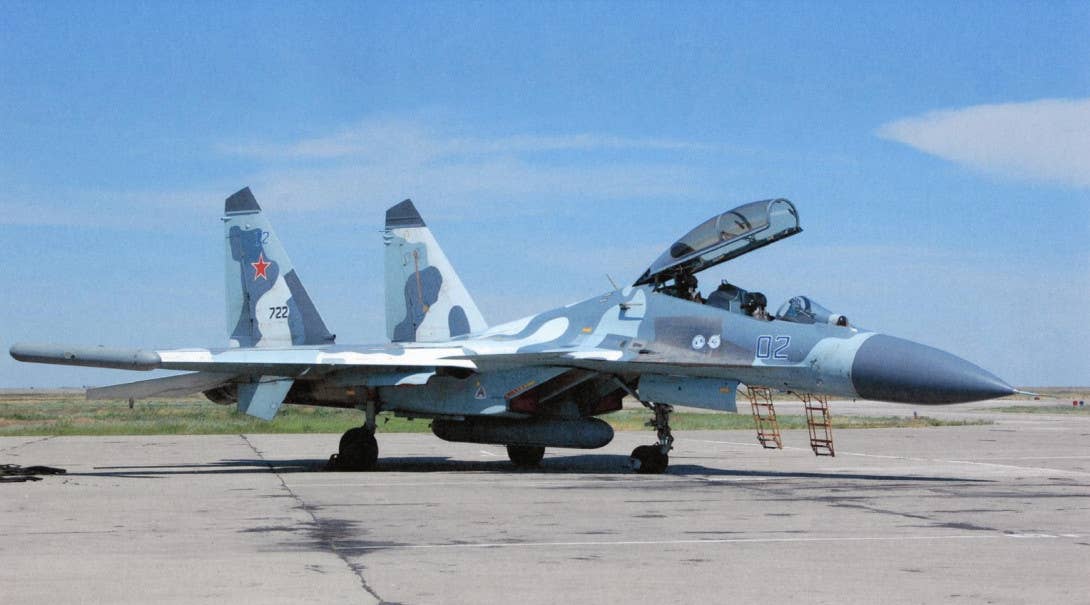With the alleged discovery of an RTU 518-PSM self-protection jamming pod during the war, another cutting-edge Russian weapon has ended up in Ukrainian hands.
This pod is part of the advanced Khibiny-U electronic warfare suite employed on the Su-30SM Flanker-H, with the serial number RF-81773 and bort number Red 62.
The pod was discovered as Ukrainian forces continued to advance eastward and southward as part of their counter-offensive. The discovery might be very valuable for Ukraine and its allies to understand the Russian EW operations.
As the Russian Army couldn't be bothered to remove the wreckage of Su-30SM 'RF-81773' that came down in a formerly Russian-controlled part of Kharkiv Oblast, Western intelligence agencies are now the proud owner of a slightly dented SAP-518SM 'Regata' jamming pod. pic.twitter.com/9BN5dPNQvi
— Oryx (@oryxspioenkop) September 12, 2022
On September 12, images of the front end of the pod went viral on social media. It was found among the remains of a Russian Su-30SM that had been taken down earlier in the conflict in the northern Kharkiv region of Ukraine.
Downed Russian Su-30SM in the Kharkiv region pic.twitter.com/R5RFdaPFcN
— ТРУХА⚡️English (@TpyxaNews) September 12, 2022
RTU 518-PSM Self-Protection Jamming Pod
Guy Plopsky, a defense analyst, pointed out, “this is a 518-PSM starboard wingtip pod. It is likely a transmitter (i.e., jammer) pod, while the port wingtip pod (designated 518-LSM1) is likely a receiver pod. The two detachable pods are part of the SAP 518-SM active ECM system, which is part of the Su-30SM’s KS REP ECM suite.”
According to a 2021 paper from the Kaluga Scientific-Research Institute for Radio Engineering, the RTU 518-PSM is a component of the Khibiny-U suite, which is mounted on Russian Su-30SM aircraft.
This is a 518-PSM starboard wingtip pod. It is likely a transmitter (i.e. jammer) pod, while the port wingtip pod (designated 518-LSM1) is likely a receiver pod. The two detachable pods are part of the SAP 518-SM active ECM system, which is part of the Su-30SM's KS REP ECM suite. https://t.co/PfSrYxHAPG pic.twitter.com/Lk1oKUJZ4T
— Guy Plopsky (@GuyPlopsky) September 12, 2022
The SAP 518-SM, sometimes known as the “complex” in Russian, comprises the internal KS REP system and two RTU 518-PSM and RTU 518-LSM1 pods on the right and left wingtips, respectively, of the aircraft.
While the RTU 518-PSM is thought to have an active jamming system, the RTU 518-LSM1 is a passive receiver that looks for threatening electromagnetic spectrum emissions, like those from adversary radars.
The SAP 518-SM subsystem, also known as Regata, is allegedly capable of spotting, jamming, and confusing the adversary’s radars, including the seekers on approaching radar-guided missiles.
This involves using Digital Radio Frequency Memory (DRFM) technology to create fictitious emissions to conceal the actual aircraft.
The internal KS REP subsystem is optimized against high-band threats. The SAP 518-SM subsystem appears to be targeted at defending against mid-band threats, providing the whole complex with a more comprehensive range of capabilities.
On the centerline, the Su-30SM can carry an extra pod known as the SAP-14, offering escort jamming capability for larger aircraft groups.
It’s unclear whether SAP-14 is a component of Khibiny-U or not, while it definitely can be used in conjunction with other aspects of that system.
Intelligence Haul For Ukraine’s & Allies?
In 2013, the Russian Ministry of Defense initially contracted KNIRTI, the pod’s manufacturer, to develop the new electronic warfare system for the Su-30SM. A year later, the Khibiny-10V, the first iteration of that system to reach operational service on any platform, was launched.
In 2018, Russian SU-30SMs were first spotted with Khibiny-U. Given that the pod appears in good shape, it might be a significant intelligence resource for the US and its partners to counter Russian weaponry.
The pod’s components, such as the computer chips and other electronics used, as well as any other parts of the related electronic warfare complex, may also contain valuable industrial intelligence.
Foreign intelligence services have significantly benefited from the war in Ukraine, particularly concerning Russia’s most sophisticated electronic warfare and air defense capabilities. Many captured systems may have already been moved abroad for additional research and evaluation.

The remains of a Su-35S that crashed near Izium in April, before Russian forces took over the area, were reported to be valuable intelligence assets for western countries.
In the latest case, the potential intelligence discovery could be significantly bigger depending on the state of other elements of the electronic warfare suite on the crashed jet. In addition to the hardware, Ukrainian intelligence operatives and their foreign allies can gather additional information.
Ukraine was believed to be a significant supplier of Soviet-designed equipment for the American military’s so-called foreign materiel exploitation (FME) enterprise even before the ongoing conflict, including fighter planes and radars.
- Contact the author at ashishmichel@gmail.com
- Follow EurAsian Times on Google News




